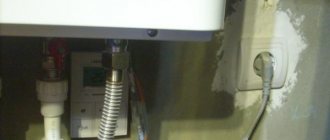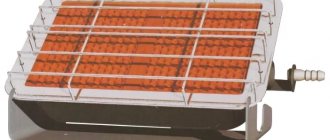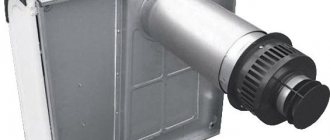Repairing a car yourself in winter is still a pleasure. In the cold, changing oil or a tire in a garage, if it is not heated, is not something any motorist really wants to do. Frost bites, so it’s difficult to cope without a good heating device.
However, you must agree that main gas today is the cheapest fuel for such equipment. At the same time, the range of devices for heating using blue fuel in stores is huge.
To make your choice easier, we've put together detailed information about what gas garage heaters are available. We analyzed their features and characteristics to make it easier to understand which device is more practical. Taking into account our advice, you can easily determine the best option for yourself.
Specifications
As a rule, utility networks are not connected to the garage, so gas in cylinders is used for heating.
The main characteristics of gas heaters for garages include:
- type of device (IR, convector, catalyst, etc.);
- developed thermal power in Watts;
- installation method (wall or floor);
- dimensions and weight;
- life time.
Each of the indicators under consideration fully characterizes a particular model and helps to choose a unit suitable for the garage.
Advantages and disadvantages
The advantages of gas heaters for garages powered by a separate cylinder are:
- compactness and mobility;
- low cost of the equipment itself and fuel for it;
- availability of energy sources;
- environmental friendliness (no combustion waste);
- ease of operation;
- long service life (15–20 years);
- speed of heating the room.
The operational safety of this heating method is beyond doubt if the necessary precautions are taken when using gas, which involve organizing effective ventilation (forced or natural).
The danger of an explosion of a gas mixture can be considered a disadvantage of the units under consideration only if the rules of their operation are violated.
Materials
You can make a gas stove yourself from stone, refractory brick or metal.
Stone structures heat up much more slowly, about five hours, but retain the accumulated heat for longer than four hours, compared to metal products. Brick structures have similar characteristics.
Metal stoves heat up quickly; in three hours they can heat a room with an area of up to 50 m2. However, they cool down quickly. The advantages can be considered light weight, ease of manufacture, and if you make the outer cladding with fireclay bricks, then the shortcomings in heat transfer will be completely smoothed out.
Types of gas heaters
Known examples of gas heaters are divided into wall-mounted models and mobile floor-standing units according to the installation method. The first ones are manufactured in the form of a convector designed for main-line mixtures, in which light methane predominates. They will need to be connected to a separate channel with fuel and equipped with a chimney.
According to their design and operating principle, industrially produced gas heaters are divided into the following types:
- convectors;
- infrared devices;
- heat guns;
- catalytic devices.
Each of these options has its pros and cons and requires separate consideration.
Infrared heaters (ceramic devices)
Infrared gas heater
The operation of IR devices is based on the principle of the thermal effect from the action of electromagnetic waves of a certain frequency. Infrared rays spread without delay throughout the room being served and heat the surfaces encountered along the way: walls, ceilings and furnishings. From them, the accumulated heat is transferred to the air.
The source of radiation in such a device is an open gas flame or a ceramic heating element that receives energy from burned fuel. The generated IR rays are collected in a special reflector and propagate in the desired direction. The advantages of infrared gas equipment include:
- independence from the power grid;
- compactness and efficiency;
- quiet operation;
- environmental cleanliness.
The disadvantage of such heaters is the inability to heat large areas (narrow focus of the thermal effect).
For small rooms, propane-powered IR emitters, made in the form of ceramic stoves with a built-in cylinder or as compact gas-heated panels, are optimally suited. Both versions of the devices are equipped with oxygen and gas leakage sensors, and also have automatic fire protection. Their power is sufficient to heat garage spaces ranging from 4 to 40 square meters. meters.
Convectors
Convector for garage
Gas convectors for garages differ from other models by the presence of a ceramic/steel heat exchanger. This heating element is first heated by an open flame and then releases heat to the outside due to air convection. There are holes in its lower part for the influx of cold air, and the same ones at the top for the exit of hot jets.
Convectors heat the room to a comfortable temperature for quite a long time, but they do it very efficiently - with minimal fuel consumption. Their advantages include combustion of gas in a closed chamber and, as a result, the impossibility of combustion products from entering the room. Gas convectors are mounted on the walls of the garage, in which a hole for the chimney is punched in advance.
Heat guns
Heat gun
This type of heater is considered the fastest in terms of speed of heating garage spaces. Heat guns have two versions, the first of which is based on the use of a built-in fan. An active electrical network is required for connection.
The second version of the product works due to the draft generated when gas is burned. The power of such a heater is significantly lower, but in this case you can do without electricity. The effectiveness of using both modifications depends on the quality of insulation of the garage structure. If the heated garage is not insulated at all, it makes no sense to count on quick and good heating of the room.
Catalytic heaters
Portable catalytic heater using gas fuel
In IR heaters of this class, heat is generated due to the effect of catalysis - the oxidation of gas on a heated surface coated with platinum. In this case, there is no open flame as such, and propane is almost completely utilized. The efficiency and thermal power indicators are almost the same as those for infrared models.
The main disadvantage of catalytic devices is their short service life, since the catalyst installed in them is designed to operate for no more than 2–2.5 thousand hours. At the end of this period, the heater is simply thrown away. As a rule, it is enough for one winter season.
Peculiarities
A gas heater for a summer residence is one of the many types of heating devices that can work both indoors and, with certain reservations, outdoors. Not all consumers immediately give preference to gas models, hesitating for a long time and choosing between them and their electric and kerosene competitors, and this is right - first you need to understand what kind of equipment it is, and what its positive and negative sides are.
Such comparisons usually start with good qualities, so let’s look at why a gas appliance is the optimal solution for summer cottages. To begin with, it should be noted that gas in our country is relatively inexpensive, and for the consumer this is a huge plus - heating a room or veranda will cost very little. In addition, gas heaters, depending on the model, can be connected directly to the pipe, that is, be stationary, or operate from a cylinder, which makes the unit portable. Of course, the benefits don’t end there, and here are the characteristics that stand out among other features:
- the mechanism of the gas heater is extremely simple - there is not a single complex component here, and therefore there is practically nothing to wear out or break, and this is a big plus for the durability of the product;
- in terms of efficiency, gas heater models are clearly among the leaders - you will pay pennies for their work, but the result will not be as modest as it might seem;
- a typical gas-powered design is small in size and, if it is a cylinder model, can be easily moved to where you need it - figuratively speaking, you can even take it with you on night fishing;
- despite the fact that during the combustion of gas, harmful substances are still released, this is the most environmentally friendly of all known types of fuel - only solar energy is cleaner;
- operation of the unit is extremely simple - although it is not advisable for children to use gas appliances, even a child could easily master the controls.
In terms of heating speed, gas models are somewhat inferior to their electric counterparts, but in a closed room, and even with regular heating, you will not see a fundamental difference, except for reduced operating costs. As befits climate control technology, each device has a built-in mechanism for adjusting the heating mode. Manufacturers do not forget to take care of fire safety, so most products, except the cheapest ones, have built-in mechanisms for blocking the gas supply if the fire goes out, as well as a tilt sensor. Considering the simplicity of the design and the minimal number of parts in it, you can expect that the device will serve the owner for at least ten years.
From the above, a picture emerges of a certain ideal heater, but a gas appliance should not be considered as such, otherwise it would have no alternatives or competitors. At a minimum, gas is a very flammable and explosive substance, and no gas can give an absolute guarantee that there will be no leakage under any circumstances; it can instantly ignite from the slightest spark, and if there is a large amount of it in a closed room, its sharp expansion provokes a powerful explosion . Of course, most consumers still avoid such a development of events - to do this, it is worth observing basic safety measures, not leaving the unit turned on when the adult owners of the house are absent. But even this is not the end of the potential disadvantages - there are some other factors to consider:
- a leak is dangerous not only due to a potential explosion, but also in itself - unburned gas displaces oxygen from the atmosphere, and if for some reason you don’t smell it, you won’t even understand the reason for the sharp deterioration in your health;
- even if the gas burns normally and there are no leaks, the combustion process itself intensively burns oxygen in the room, instead forming carbon dioxide - without productive ventilation, a person will, at best, feel a noticeable malaise.
Rules for choosing gas heaters for the garage
To choose the right gas heater for your personal garage, you should take into account the specific operating conditions. If you have to stay in the garage for a long time, it is best to purchase a convector. When operating conditions require quick heating, it is wiser to use a heat gun.
IR heaters are ideal for maintaining a comfortable room temperature throughout the day. When evaluating catalytic devices, it is important to consider their high price, which is justified by fire safety and minimal oxygen combustion. Ceramic models are characterized by low price and long service life.
Safety precautions
When using a gas heater, the garage must be ventilated.
Gas heaters are devices during the operation of which it is important to comply with the following safety requirements:
- It is not allowed to cover the working part of the device with cloth items, which are sometimes hung out to dry;
- the garage space must be ventilated;
- When using the unit, it is prohibited to remove the protective grille;
- It is not allowed to direct thermal radiation at flammable liquids, as well as cloth and paper objects.
If the user manual specifically specifies the operating position of the unit, it is not allowed to change it to another placement option.
How to make a stove for a garage from a cylinder
Preparing the container for use:
- make sure the container is empty;
- unscrew the valve;
- drain all liquid.
Remove the valve using an adjustable wrench (put a piece of pipe on the handle to increase the leverage) or a vice. In the latter case, the tap is clamped in a vice, and the cylinder is rotated using a chain and a long pipe or crowbar.
To turn the cylinder, the valve of which is clamped in tension, use a long lever
Before cutting the cylinder, water is poured inside. This can be done using a thin tube, a watering can, or any available cone-shaped container. In order for air to escape unhindered during continuous pouring (using a hose), it is necessary to move the watering can from time to time, otherwise water will flow through the top. Another option is to install a short tube of small diameter between the watering can and the neck, through which air can easily flow inside. If you pour water in portions (with a ladle, ladle), then such precautions will not be required.
While filling the cylinder, residual gas comes out of it, so this operation must be carried out outdoors or with the garage door wide open
The upper part of the cylinder is carefully cut off with a grinder; in the future, it will make an excellent door for the stove
To attach the stove door to the body, you can take ordinary metal hinges (at least two) or several links of a thick chain
A rectangular groove is cut along the long side to install the ash pan (approximately 10-14 cm in width)
The grate is a grate at the bottom of the firebox on which firewood is stored. If you plan to burn with logs or scraps of boards, then the grate spacing can be several centimeters, but if sawdust is used as fuel, then a smaller distance is needed. Sometimes the grate is welded to the gas cylinder from the inside, but this is not necessary. Moreover, once the grate burns out, it will be difficult to replace.
The grate is made from scraps of rod or the reinforcement is bent into a snake
One of the necessary elements of a garage stove made from gas cylinders is a chimney. The functionality of the structure depends on the diameter of the selected pipe and its location. It is not necessary to buy a specialized pipe; you can take what you have on hand.
A small metal cylinder is welded to the hole for the smoke exit, the diameter is slightly smaller than the chimney; the pipe should fit tightly onto the outlet pipe, preventing smoke from entering the garage
Correspondence of the chimney diameter to the volume of the gas cylinder:
- 60 mm minimum for 12 l container;
- 80 mm – for a 27-liter cylinder;
- 120 mm - for a 50-liter.
The entire structure is installed on legs made of a corner or square profile
. To ensure that as much heat as possible remains in the garage, the chimney can be made from several sections of pipe connected at a slight angle. Then you need to build protective screens from sheets of metal, attach them to the body and test the stove. To create good draft, the top edge of the chimney must be placed at least 1 m above the garage roof.
Review of industrial models
Gas equipment, like a diesel garage heater powered by diesel fuel, is not recommended to be made independently. Experts advise purchasing industrial devices from a trusted manufacturer. The international holding Ballu Industrial Group with representative offices in 6 countries, including Russia, China and Japan, has proven itself well in the domestic market.
Another well-known company Kovea from South Korea specializes in gas equipment, almost half of which is sold on the Russian markets. The well-known Swedish concern Timberk, which produces modern water heaters, as well as heating and climate control equipment, is equally popular.
An example of a model designed specifically for the garage is the ceramic heater TGH 4200 X1, which has a floor stand. HPV GmbH is not a well-known company to most Russians. A sample of its products is the portable IR heater “4200 ZS” with a power of 4.3 kW.
Price
The range of gas heaters includes models for garages. They are compact, easy to connect and maintain, and do not require electricity. In order of increasing price, it is enough to define three groups:
- Gas catalytic burners are the simplest design, with minimal protection. The cost ranges from 800-2500 rubles.
- Infrared heaters with a catalytic burner - the presence of a housing, a convenient grip or stand, compact dimensions and often directed action. The cost ranges from 1300-4500 rubles.
- Ceramic heaters - presence of a housing, directional action, safe temperature of the heating element, protective grille and reflector. Price from 2500 rub.
| Name | power, kWt | Type | price, rub. |
| Solar gas GII 2.3 | 2,3 | ceramic | 810-900 |
| Neoclina UK-04 | 3,7 | catalytic | 1100-1340 |
| "COMFORT" GO-3.5 kW | 3,5 | catalytic | 1300-1640 |
| Elitech TP 3GI | 3,2 | ceramic | 2730-2900 |
| NeoClima UK-02 | 3,7 | ceramic | 2890-3500 |
| Timberk TGH 4200 SM1 | 4,0 | ceramic | 4500-4650 |
| Gas oven Hyundai H-HG1-42-UI577 | 4,2 | catalytic | 5720-5900 |
| Caliber GKO-4200 | 4,2 | ceramic | 7020-7300 |
Homemade gas heaters for the garage
Homemade heater
The main advantage of such a device is that its manufacture does not require expensive branded parts. In this case, it is possible to make do with improvised components available to any garage owner.
Preparation of materials
To make a gas heater you will need to prepare:
- branded burner with valve;
- sheet of tin of suitable size;
- tin scissors;
- electric drill with a set of drills;
- riveter and rivets for it.
To make a protective grille, you will need a piece of fine-mesh metal mesh of the desired shape.











